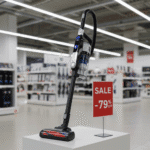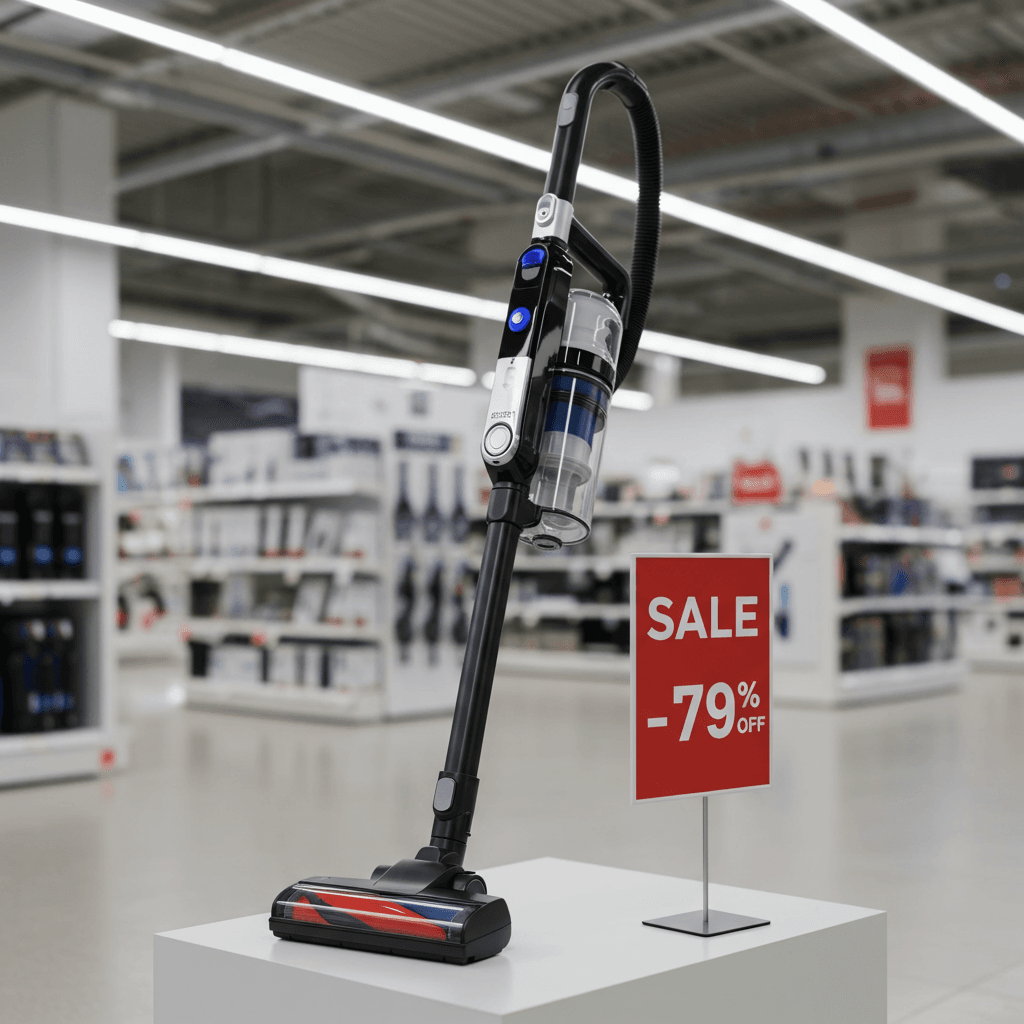
Don’t Get Sucked In: The Ultimate Guide to Nailing the UK Vacuum Cleaner Sale
Let’s be honest, for most of us, vacuuming is a chore. It’s that relentless task on the weekend to-do list, the necessary evil that stands between you and a truly relaxing Saturday afternoon. But what makes it infinitely more frustrating is wrestling with a vacuum cleaner that’s simply not up to the job. One that spits out more dust than it collects, weighs a ton, or has a cord that seems determined to trip you up at every turn. If this sounds painfully familiar, then the siren song of a vacuum cleaner sale is likely music to your ears. But hold your horses before you dash off and grab the first shiny machine with a massive discount sticker.
Navigating a sale can be a minefield. It’s a whirlwind of dazzling deals, confusing technical jargon, and the nagging fear that you might be buying a dud. This guide is your map and compass. We’re going to delve deep into the world of vacuum cleaners, demystify the technology, and arm you with the knowledge to confidently stride into any sale – be it online or on the high street – and emerge victorious with a machine that’s perfect for your home, your lifestyle, and your wallet. Prepare to transform your cleaning routine from a dreaded task into a strangely satisfying one. A great vacuum really can do that.
Timing is Everything: When to Pounce on the Perfect Price
You wouldn’t go fishing without knowing the best time for a catch, and hunting for a vacuum bargain is no different. Retailers orchestrate their sales events with precision, and knowing the calendar can save you a significant amount of money. Keep your eyes peeled during these key periods:

Black Friday and Cyber Monday
This is the big one. The late November shopping extravaganza is arguably the best time of year to buy a new vacuum cleaner. Retailers across the UK, from Currys and Argos to John Lewis and Amazon, slash prices on a massive range of models. The competition is fierce, which means the deals are often spectacular. The key to success here is preparation. Know which models you’re interested in beforehand, as the best deals on popular brands like Dyson and Shark can sell out in a flash.
January Sales
The post-Christmas slump is a brilliant time for bargain hunting. Retailers are keen to clear out old stock to make way for the new season’s models, and households, fresh from the chaos of the festive season, are often in the mood for a home reset. This means deep discounts on excellent, albeit soon-to-be-last-season, vacuum cleaners. Don’t let that put you off; a flagship model from last year is still a phenomenal piece of kit.
Spring Cleaning Season
As the days get longer and the sun starts streaming through our windows (revealing every last speck of dust), the motivation for a deep clean skyrockets. Retailers know this. Around March and April, you’ll see promotions themed around ‘Spring Cleaning’. This is a fantastic time to find deals, especially on machines with features suited to a thorough home overhaul, like powerful uprights and models with a plethora of attachments.
Amazon Prime Day
If you’re an Amazon Prime member, this mid-summer sale (usually in July) is a date for your diary. It’s a huge event with exclusive deals on thousands of products, and electronics like vacuum cleaners are always front and centre. You can expect significant price drops on a wide array of brands, from budget-friendly Eufy robot vacuums to premium Shark cordless sticks.
Bank Holiday Weekends
Never underestimate the power of a Bank Holiday sale. These three-day weekends are a retailer’s dream, and you’ll often find tempting offers on home appliances. They might not always be as dramatic as the Black Friday discounts, but they can still represent a solid saving, especially if you need a new vacuum urgently and can’t wait for the major sale events.
Know Your Arsenal: A Deep Dive into Vacuum Cleaner Types
Choosing a vacuum is no longer a simple case of picking one that looks nice. The technology has evolved, and today’s market is filled with different types, each designed for a specific purpose and home. Understanding the pros and cons of each is the most crucial step in your buying journey.
The Traditional Workhorse: Upright Vacuums
Picture a classic vacuum cleaner, and you’re probably thinking of an upright. These sturdy, powerful machines are a fantastic choice for homes with large, carpeted areas. Their design often incorporates a motorised brush bar that agitates carpet fibres to lift out deep-seated dirt and pet hair effectively. Brands like Shark have revolutionised this space with features like Lift-Away technology, where the main cylinder detaches to become a portable unit for cleaning stairs and upholstery.
- Best for: Large homes, deep cleaning carpets, powerful suction.
- Consider: They can be heavy and less nimble for getting under low furniture or doing the stairs (unless they have a lift-off feature).
The Agile Companion: Cylinder Vacuums
Cylinder vacuums, those little pods you pull along behind you, offer a different kind of convenience. The main body of the machine is separate from the cleaning head and wand, making the part you hold significantly lighter. This makes them brilliant for navigating stairs, cleaning the car, and reaching into awkward corners. The iconic Henry Hoover is a testament to the durability and effectiveness of this design, but brands like Miele offer high-tech versions with incredible filtration and quiet operation.
- Best for: Homes with a mix of hard floors and carpets, cleaning stairs, versatility.
- Consider: They can be a bit clumsy, sometimes bumping into furniture or getting tangled, and storage can be awkward with the separate hose and body.
The Modern Must-Have: Cordless Stick Vacuums
Cordless vacuums have taken the UK by storm, and for good reason. The sheer convenience of being able to just grab it off the wall and tackle a mess without faffing with plugs and cords is a game-changer. Once only suitable for quick clean-ups, modern cordless sticks from brands like Dyson, Shark, and Vax now boast power and battery life that can rival their corded cousins. They are lightweight, versatile, and often convert to a handheld vacuum in seconds.
- Best for: Quick daily clean-ups, smaller homes and flats, homes with lots of hard floors.
- Consider: Battery life is the key factor. Check the run-time on the power setting you’ll actually use, not just the eco-mode. Dustbin capacity is also smaller, requiring more frequent emptying.
The Effortless Butler: Robotic Vacuums
For the tech-lover or the truly time-poor, a robot vacuum is the ultimate luxury. These smart little discs autonomously navigate your home, sucking up daily dust and debris while you’re out or putting your feet up. Brands like iRobot and Eufy offer models with clever mapping technology, app control, and even self-emptying bases. They won’t replace a deep clean with a powerful upright, but for maintaining a baseline level of cleanliness, they are fantastic.
- Best for: Daily maintenance, pet owners (for constant fur collection), open-plan living spaces.
- Consider: They can get stuck on rugs or cables, can’t clean stairs, and the quality of their navigation and cleaning ability varies wildly with price.
Decoding the Jargon: Features That Genuinely Matter
Once you’ve settled on a type, you’ll be faced with a list of features. Here’s what you should actually pay attention to during a vacuum cleaner sale.
Suction Power vs. Motor Wattage
Don’t be fooled by a high wattage number on the box. This measures the power going *into* the motor, not the suction power coming *out*. The true measure of effectiveness is ‘Air Watts’ (AW). This figure combines the airflow and the suction pressure to give a much more accurate representation of cleaning power. A well-designed vacuum with 200AW can be far more effective than a poorly designed one with a 1200W motor.
The Great Filtration Debate: HEPA is King
A vacuum’s job is to trap dust, not just move it around. This is where filtration comes in. For allergy sufferers or anyone concerned about air quality, a HEPA (High-Efficiency Particulate Air) filter is non-negotiable. These filters are certified to trap 99.97% of microscopic particles, including pollen, pet dander, and dust mites, leaving the air that exits the vacuum cleaner than the air that went in.
Bagged vs. Bagless
This is a matter of personal preference. Bagless vacuums, popularised by Dyson, are convenient and have no ongoing cost for buying bags. You can see the dirt you’ve collected, which is strangely satisfying. The downside is that emptying the dust canister can be a messy, dusty job. Bagged vacuums are more hygienic to empty – you just remove the bag and bin it. The sealed system is often better for allergy sufferers, but you do have the recurring cost of replacement bags.
Tools and Attachments
A vacuum is only as good as its tools. Don’t overlook what comes in the box. A crevice tool for tight corners and a dusting brush are standard. If you have pets, a motorised pet tool is essential for pulling stubborn hair from carpets and upholstery. An upholstery tool is great for sofas and curtains. Some premium models, like Shark’s Flexology vacuums, have a bendy wand to get under furniture without you having to bend down – a real back-saver!
For the Cordless Crew: Battery Life and Charge Time
This is the most critical factor for any cordless model. Look at the quoted run time with a critical eye. Is that 60-minute run time on the lowest eco-setting? How long does it last on max power? For an average-sized home, you’ll want at least 20-30 minutes of realistic, powerful cleaning time. Also, check the charge time – some can take 4-5 hours to fully recharge. Some brands offer models with swappable batteries, allowing you to have a spare fully charged and ready to go.
Your Pre-Sale Shopping Checklist
You’re almost ready. Before you hit ‘buy now’, run through this final checklist to ensure you’re getting a genuine bargain on a machine you’ll love.
- Do Your Research First: Don’t wait for the sale to start. Decide on your preferred type and must-have features now. Make a shortlist of 2-3 models you’d be happy with.
- Check the Price History: A “sale” isn’t always a sale. Some retailers inflate prices just before a sale event to make the discount look bigger. Use a browser extension or price tracking website to check a product’s price history on sites like Amazon.
- Read Independent Reviews: Customer reviews on retailer websites are useful, but seek out independent reviews from sources like Which?, Good Housekeeping, or trusted tech websites. They put machines through rigorous, standardised tests.
- Consider a Refurb: Don’t dismiss manufacturer-refurbished models. These are often customer returns that have been professionally tested, cleaned, and repaired. They come with a warranty (usually 6-12 months) and can offer incredible value for money.
- Check the Warranty: A long warranty is a manufacturer’s vote of confidence in their own product. A 1-year warranty is standard, but many reputable brands like Shark and Miele offer free 5-year guarantees upon registration. This is a huge factor in the long-term value of your purchase.
Armed with this knowledge, you are no longer just a hopeful shopper; you are a savvy consumer ready to conquer the vacuum cleaner sale. You can look past the flashy marketing and focus on what truly matters: power, performance, and suitability for your home. Finding that perfect machine at a price that makes you smile will make the weekly chore of vacuuming feel less like a battle and more like a victory lap. Happy hunting!







